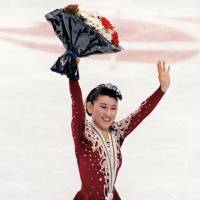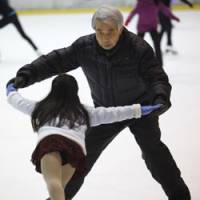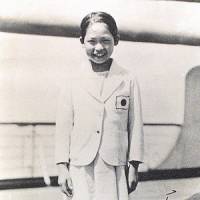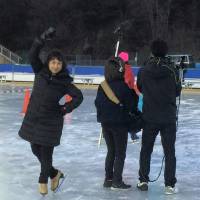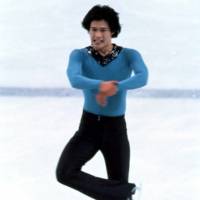I was hit by a thunderbolt last week.
Sometimes creative thoughts bounce around in our heads for a while before coalescing in a moment of clarity. That is what happened with me.
What is it I came up with?
Pretty straightforward.
The idea to have a Japan Figure Skating Hall of Fame.
I believe the time has come for Japan's legion of great skaters, coaches and contributors to be recognized and for their legacies to have a permanent place to call home.
When you look at Japan's long history in skating, going back to the country's first ice rink in Sendai early in the 20th century, to the appearance of 12-year-old Etsuko Inada at the 1936 Olympics in Garmisch-Partenkirchen, Germany, up to Yuzuru Hanyu's epic free skate at the 2017 world championships, you can see that there is no shortage of significant accomplishments or worthy candidates.
The more I thought about this prospect, the more I wondered why it had not been done before. Better late than never, I say.
Both the World Figure Skating Hall of Fame and the U.S. Figure Skating Hall of Fame were not created until 1976, nearly three decades after Dick Button won the first Olympic gold medal by an American skater.
The U.S. Hall of Fame began with a total of 15 inductees. The names included Button and fellow Olympic gold medalists Tenley Albright, Peggy Fleming, Carol Heiss, David and Hayes Jenkins, as well as Maribel Vinson Owen and Jackson Haines.
The World Figure Skating Hall of Fame, now 42 years old, began with a class of 20. It has just two Japanese members — Midori Ito (elected in 2004) and Nobuo Sato (elected in 2010).
So the first of many issues that must be resolved for a Japan Figure Skating Hall of Fame are who should be included in the inaugural class and where should it be located?
I think you should start with an opening group of five or six people, then induct a maximum of one to three individuals in each successive year. There are many worthy candidates, but I believe for it to be meaningful the buildup of members should be incremental. Those with the credentials will make it in time.
After a week of thoughtful deliberation and soliciting input from those in the skating community as well as my Twitter (@sportsjapan) followers, I have come up with six individuals I think should comprise the initial class of the Japan Figure Skating Hall of Fame.
First the automatics, or as they say in baseball, the "first-ballot" selections. Here are Ice Time's choices:
✺ Nobuo Sato — A renowned skater and coach, the Osaka native was a 10-time Japan champion, skated in two Olympics (1960, 1964), and finished fourth at the 1965 world championships in Colorado Springs.
He went on to coach the likes of Mao Asada, Miki Ando, Yukari Nakano, Takahiko Kozuka and his daughter Yuka (the 1994 world champion) and is still working to this day at age 76.
✺ Midori Ito — Japan's first world champion (1989) and the silver medalist at the 1992 Albertville Olympics. Most significantly, the Nagoya native was the first woman to land a triple axel and a triple/triple combination in international competition.
✺ Etsuko Inada — Japan's first female Olympic competitor (in 1932), she was a seven-time Japan champion. Most incredibly, her final two Japan titles came 10 years apart due to World War II. She won her sixth title in the 1940-41 season and came back to reign again in 1950-51. Amazing.
Inada went on to be an instructor at Tokyo's Meiji Jingu rink for decades before passing away at the age of 79 in 2003.
Next are those with significant achievements and contributions to skating:
✺ Machiko Yamada — The legendary coach is still going strong at the age of 74. She led Ito to the watershed first world title in 1989 and went on to mentor Mao, Nakano and Kanako Murakami in her long career.
Yamada can still be seen by the boards in her long coat today instructing 2017 world silver medalist Shoma Uno and rising junior star Mako Yamashita. Longevity is important when it comes to judging one's impact on their sport and Yamada has it in abundance.
✺ Emi Watanabe — Japan's first female medalist at the world championships, taking the bronze in 1979 in Vienna. Watanabe, whose father is Japanese and mother is Filipino, was an eight-time Japan champion who competed in two Olympics (1976, 1980). She placed sixth at the Lake Placid Games.
She went on to become a television celebrity and help popularize skating in Japan with her many appearances. The Tokyo native still skates in shows to this day. When Ice Time interviewed Kristi Yamaguchi last summer, she mentioned Watanabe's prominence in the sport to me.
✺ Minoru Sano — The first Japanese medalist at the world championships when he earned the bronze in 1977 in Tokyo. Sano was so far ahead of his time that it took 25 more years for another Japanese man to make the podium at the worlds (until Takeshi Honda earned the bronze in 2002 in Nagano).
Hailing from Yamanashi Prefecture, he finished ninth at the 1976 Olympics in Innsbruck, Austria. He went on to found the first ice show in Japan in 1978 (Viva! Ice World") and coached Shizuka Arakawa and Yamato Tamura.
A Japanese coach sent their suggestions for the opening class to Ice Time in an email last week.
"For sure Nobuo Sato, Etsuko Inada, Tsuyako Yamashita, Minoru Sano, Midori Ito. Shizuka Arakawa also if age is not a factor."
One of my Twitter followers (@DreamofPinkElep) saw it almost identically to Ice Time. They sent in the following selections for the inaugural Japan Figure Skating Hall of Fame class.
"Etsuko Inada, Nobuo Sato, Shoichiro Tsuzuki, Hideo Sugita, Minoru Sano, Emi Watanabe are the first batch. More to follow for younger generations."
I agree with this philosophy. Of course Mao will make it in time, but many have come before her and they deserve to be recognized first.
Names like Tsuzuki (Hanyu's first coach), who coaches at the Yokohama Bank rink near Higashi-Kanagawa Station, and Yamashita, now 89, who was one of the founders of the Japan Figure Skating Instructor's Association, definitely warrant early induction.
Along these lines, I think a five-year waiting period after a skater's final competitive season is appropriate, as is the case with the Baseball Hall of Fame in Cooperstown, New York, and the Basketball Hall of Fame in Springfield, Massachusetts.
Names like Mao, Arakawa, Ando, Daisuke Takahashi, Honda and others would certainly be elected in due course.
Location not an easy call
So where should a Japan Figure Skating Hall of Fame be located?
This may be tougher than deciding who gets in the first year. Sendai, as the birthplace of figure skating in the nation and also the hometown of both Hanyu and Arakawa as youngsters, would certainly have to be given serious consideration.
But when you look at the extraordinary number of skaters that Nagoya has produced, there is a pretty compelling argument for the Hall to be there especially when considering its central location.
Tokyo, Osaka, Kyoto and Kobe all merit also being included in any conversation.
I think the Hall should be a permanent structure and backed by a city or prefectural government and supported by the Japan Skating Federation. A board should be appointed to annually review nominations and make selections, with those elected honored at an annual dinner.
Japan's deep respect for its culture and elders would factor significantly in the presentation of the Hall. Ice Time envisions a place full of historical artifacts, including skates and costumes of members, career records, and a timeline of the evolution of the sport to the present day.
This should be a place where young and old could come to witness and learn about skating history. There should be articles, photos and videos of the members in competition (when available) as well as past and present interviews with them.
Information about every skating club in Japan should be easily available as well for youngsters who are interested in taking up the sport. Skating books and videos should also be sold at the Hall.
I'm going to do everything I can to see that a Japan Figure Skating Hall of Fame becomes a reality.
Hearts of gold
A couple of heartwarming crowdfunding cases came to Ice Time's attention recently.
First, is that of Joshua Farris, an American skater who was the world junior champion in 2013, but has suffered multiple concussions in his career and has been unable to compete since 2015 due to the effects of the brain injuries.
Medical examinations have determined that Farris needs to undergo special eye and brain therapy to retrain his brain to use his right side and right eye. On Jan. 6 a campaign was started at www.gofundme.com/joshs-eye-and-brain-therapy-fund with an initial goal of $5,000 to help raise the money for his rehabilitation. In just nine days the total is now at $12,790.
Crowdfunding campaigns are nothing new, but what moved me was the large number of Japanese names who have contributed for Farris. Scrolling down the list of donors I found one Japanese name after another. Incredible.
Second, is Mirai Nagasu's support team. Nagasu has made the U.S. team for the Pyeongchang Olympics, but her home club (the Pasadena Figure Skating Club) wanted to ensure that her boyfriend and family members could also attend to support the Southern California native.
So a campaign began last week at www.youcaring.com/mirainagasu-1066185 with a goal of $11,000. In less than a week the goal has been realized with the tally now at $11,363.
Once again, Ice Time noted a large number of Japanese supporters contributing and offering messages of encouragement to Nagasu. Most of the donors chipped in something in the range of $20 to $50, but one (Yuri Nara) gave $500 and posted a heartfelt message in Japanese. Absolutely phenomenal.
This proves to Ice Time that the passion of Japanese skating fans is surpassed only by their compassion for those in need.



